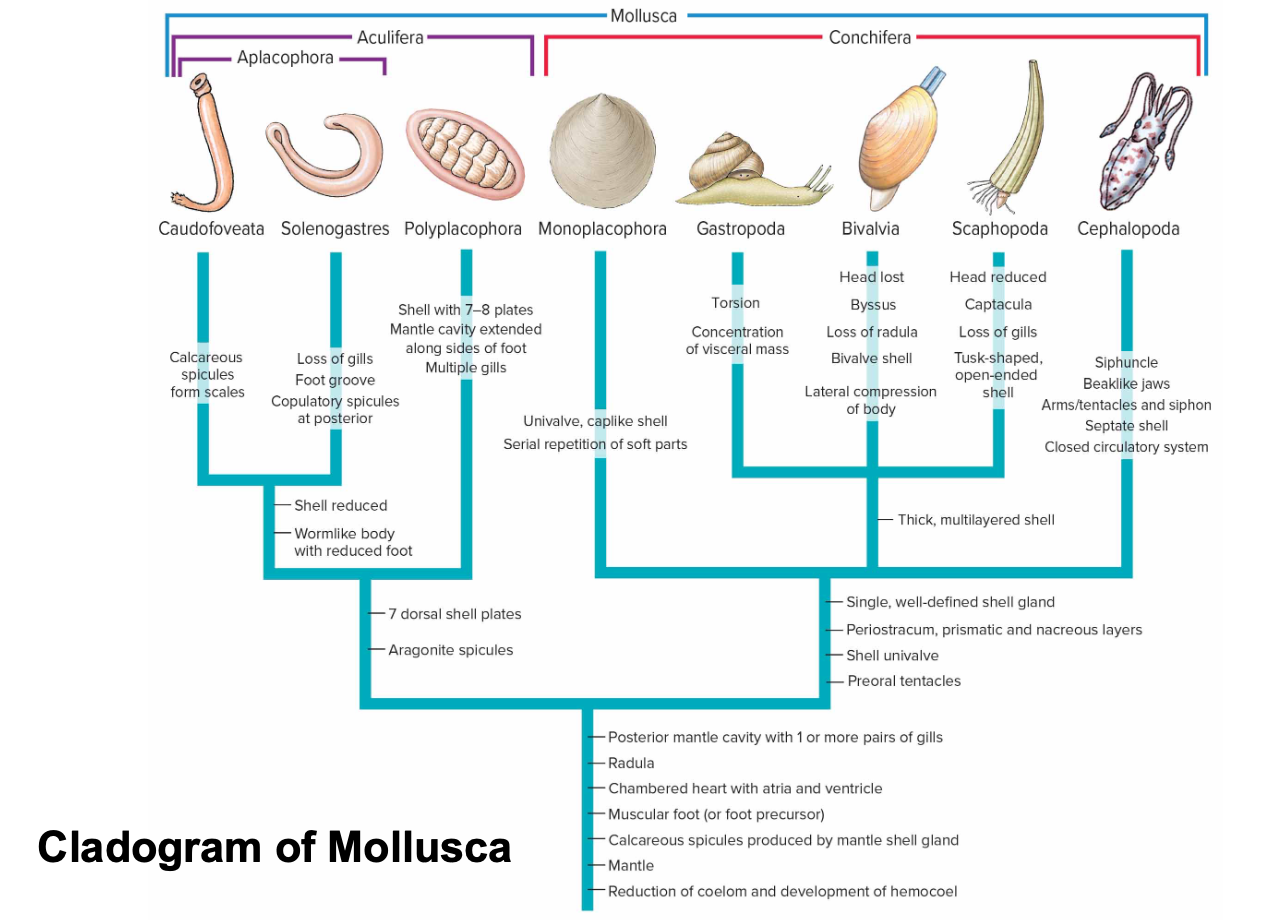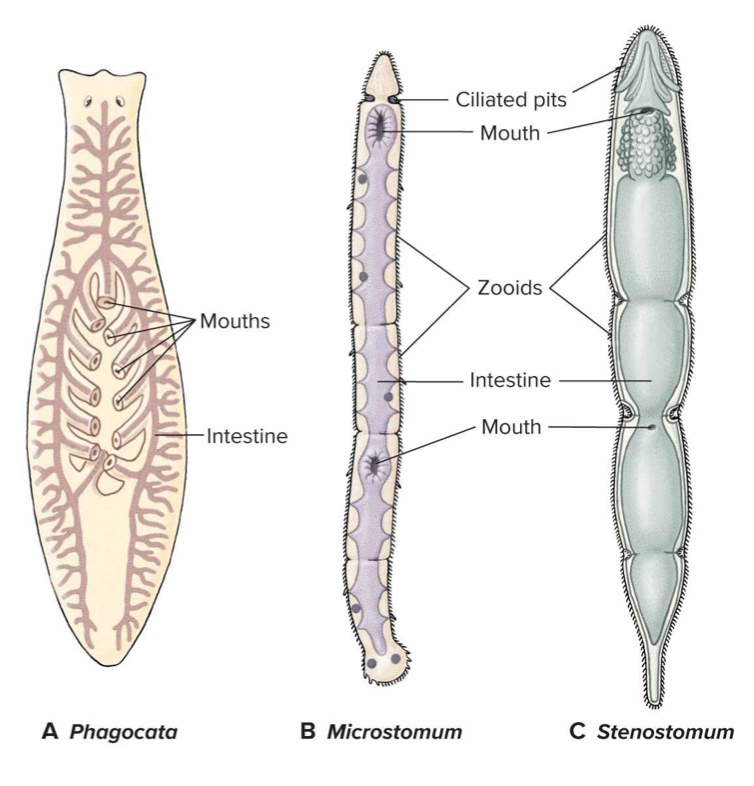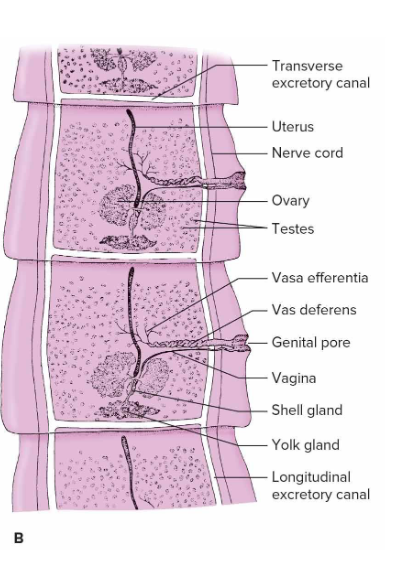Chapter 8: Worms Part 1
0.0(0)
0.0(0)
Card Sorting
1/39
Earn XP
Description and Tags
Study Analytics
Name | Mastery | Learn | Test | Matching | Spaced |
|---|
No study sessions yet.
40 Terms
1
New cards
Cephalization
Evolution of heads, found in worms and more complex animals
2
New cards
Direct Development
Development without a feeding larval stage found in worms
3
New cards
Hydrostatic Skeleton
Flexible skeleton that is supported by internal fluid pressure found in worms
4
New cards
Phylum Platyhelminthes
- "flatworms"
- Vary from millimeter to many meters in length
- Some free-living others are parasitic
4 classes of Platyhelminthes (getting redefined)
1. Turbellaria (free living (commensal not hurting or harming environment), or parasitic, oldest group)
2. Trematoda (endoparasitic flukes)
3. Monogenea (ectoparasitic flukes)
4. Cestoda (endoparasitic tapeworms)
- Vary from millimeter to many meters in length
- Some free-living others are parasitic
4 classes of Platyhelminthes (getting redefined)
1. Turbellaria (free living (commensal not hurting or harming environment), or parasitic, oldest group)
2. Trematoda (endoparasitic flukes)
3. Monogenea (ectoparasitic flukes)
4. Cestoda (endoparasitic tapeworms)

5
New cards
Class Turbellaria
- Mostly free-living
- Move via wave
- Some may have multiple mouths
- Most have simple or no gut
- Simple pharynx
- Yolks can help define the egg types
- "Penis Fencing"
- Move via wave
- Some may have multiple mouths
- Most have simple or no gut
- Simple pharynx
- Yolks can help define the egg types
- "Penis Fencing"

6
New cards
Class Trematoda
*parasitic flukes*
Adaptations
- Can produce cysts (allows them to be dormant
- Penetration glands
- Hooks and suckers for adhesion
- Increased reproductive capacity
- Lack of sense organs (poorly developed)
- Do not have cillia
Adaptations
- Can produce cysts (allows them to be dormant
- Penetration glands
- Hooks and suckers for adhesion
- Increased reproductive capacity
- Lack of sense organs (poorly developed)
- Do not have cillia
7
New cards
Class Monogena
- Monogenetic flukes
- More related to cestoda (were part of trematoda)
- Mostly external fluke
- Likes to be on fins and gills of fish (very common)
- More related to cestoda (were part of trematoda)
- Mostly external fluke
- Likes to be on fins and gills of fish (very common)
8
New cards
Opisthaptor
a hook or sucker used by monogenea to attach (hook on) to organs
9
New cards
Class Cestoda
- Have a scolex and proglottid
- Receive their nutrition from diffusion of host nutrients
- Can get them from contaminated drinking water and food
- Requires at least 2 hosts
- Usually does not effect hosts unless they are already sick
- Receive their nutrition from diffusion of host nutrients
- Can get them from contaminated drinking water and food
- Requires at least 2 hosts
- Usually does not effect hosts unless they are already sick
10
New cards
Flukes
common name for trematodas and monogenea, type of parasite
11
New cards
Tapeworms
Part of the Class Cestoda, require two hosts and are internal parasites that can live off of the bacteria and nutrients in humans and animals stomachs (GI tracts)
12
New cards
Tegument
outer covering of a tape worm that absorbs nutrients since they lack a digestive system
13
New cards
Protonephridia
"before-kidney", an excretory tubule that lacks an internal opening, found in Platyhelminthes, rotifers, and some chordates, either not found or reduced in marine flatworms
14
New cards
Solenocytes
Flagella at the end of the tubules in the protonephridia that moves water and waste to be shot out of the pore of the body (used a lot with freshwater invertebrates)
15
New cards
Flame Cells
Cilia at the end of the tubules in the protonephridia that moves water and waste to be shot out of the pore of the body (used a lot with freshwater invertebrates)
16
New cards
Subepidermal Nerve Plexus
Nervous system found in worms that resembles nerve net of cnidarians
17
New cards
Ocelli
light sensitive eyespots, present in turbellarians, monogeneans, and larval trematodes
18
New cards
Auricles
ear-shaped (look like flaps), filled with nerve endings that pick up vibrations and sense pain, connected to nerve net, composed of tactile and chemoreceptive cells
19
New cards
Rheoreceptors
sense direction of water currents in some, composed of tactile and chemoreceptive cells
20
New cards
Asexual Fission
reproduction found in most worms where they constrict behind the pharynx and separate into two animals
21
New cards
Monoecious
One sex (synonym for hermaphrodites) Almost all worms are this. Opposite of dioecious
22
New cards
Hermaphordites
One sex (synonym for monoecious) Almost all worms are this. Opposite of gonochoric
23
New cards
Penis Fencing
Occurs in Turbellaria class where the sperm is not free swimming and has pierce the skin in order to fertilize. This can lead to a violent/aggressive battle of insemination
24
New cards
Clonorchis sinensis
"Human liver fluke" that can infect humans, cats, dogs, and pigs, very common in southeast Asia, flukes live in the bile passage of the host, causes sorosis of the liver
25
New cards
Schistosomes
"Blood Flukes" that infect the blood, common infection, found in Africa, south America, West Indies, and the Middle and Far East
26
New cards
Schistosome dermatitis
"swimmers itch", occurs when cercaria (snails) penetrate an unsuitable host such as a human (needs a bird instead), treated with praziquantel
27
New cards
Scolex
anterior (head) end in Cestoda (tapeworms) that has little suckers and hooks to burrow into the intestinal tract
28
New cards
Proglottids
repeated sections that allow them to grow, segmentation, when chained together become strobila, each section contains uterus, ovary, testes, genital pore, and vagina

29
New cards
Taenia saginata
Beef tapeworm that is found in undercooked beef (in the inner muscular tissue of cattle), mature adult worms can reach over 7 meters
30
New cards
Taenia solium
Pork tapeworm where pigs are intermediate hosts and humans are definitive, found in undercooked pork, infects the eyes and brain of the human and can lead to seizures and death from cysts.
31
New cards
Phylum Gastrotricha
- Have scales
- Covered in cillia (ciliated)
- Small
- Hermaphrodites
- Covered in cillia (ciliated)
- Small
- Hermaphrodites
32
New cards
Phylum Gnathostomulida
- Very small, larger than gastrotricha
- About 80 species (probably more)
- They can endure low oxygen envionrments
- Scrappers (scrape of substrate of bacteria)
- Acoelmates
- About 80 species (probably more)
- They can endure low oxygen envionrments
- Scrappers (scrape of substrate of bacteria)
- Acoelmates
33
New cards
Phylum Rotifer
- *Has a rotating mouth piece that has ciliated crown (corona)*
- Very complex at a small size (max length 3mm)
- Have different lifestyles
- Very complex at a small size (max length 3mm)
- Have different lifestyles
34
New cards
Phylum Acanthocephala
- Spiny-headed worms
- Endoparasites in the intestines of vertebrates
- Found in fish, birds, and mammals
- Endoparasites in the intestines of vertebrates
- Found in fish, birds, and mammals
35
New cards
Defining Characteristics of Worms
- BILATERAL SYMMETRY
- Cephalization- evolution of heads
- Triploblastic (3 germ layers)
- Begin to have "hunters", actually seeking out food
- Has a nervous system, more complex than cnidarians
- Cephalization- evolution of heads
- Triploblastic (3 germ layers)
- Begin to have "hunters", actually seeking out food
- Has a nervous system, more complex than cnidarians
36
New cards
Body cavity
defining characteristic of worms, a fluid filled space or compartment in the body that houses organs and structures
3 types
1. Coelomates (have fluid filled cavities)
2. Acoelomates (organisms that lack a body cavity)
3. Psuedocoelomates (a partial coelom (body cavity))
3 types
1. Coelomates (have fluid filled cavities)
2. Acoelomates (organisms that lack a body cavity)
3. Psuedocoelomates (a partial coelom (body cavity))

37
New cards
Psuedocoelomates
a partial coelom (body cavity), Pseudo means false, organisms that have an internal cavity that is not completely lined with mesoderm tissue
2 phyla of pseudocoelomates
1. Rotifera
2. Acanthocephala
2 phyla of pseudocoelomates
1. Rotifera
2. Acanthocephala
38
New cards
Syncytial Tegument
external body covering found in all parasitic Platyhelminthes
39
New cards
Strobila
a stacked section of proglottids in Cestoda
40
New cards
Proglottids hosts
requires two hosts, the first is invertebrate and second is vertebrates usually